Understanding Do Not Resuscitate Orders and Forms
This file provides detailed information about Do Not Resuscitate Orders (DNRO) including instructions for obtaining and completing the form. It answers common questions regarding the use, legal standing, and revocation of the order. Ideal for individuals considering their end-of-life care options.
Edit, Download, and Sign the Understanding Do Not Resuscitate Orders and Forms
Form
eSign
Add Annotation
Share Form
How do I fill this out?
Filling out the DNRO form correctly is crucial for it to be honored by medical professionals. Start by ensuring that you have a physician's signature as this validates the order. Make sure to keep a copy in an easily accessible place for emergencies.
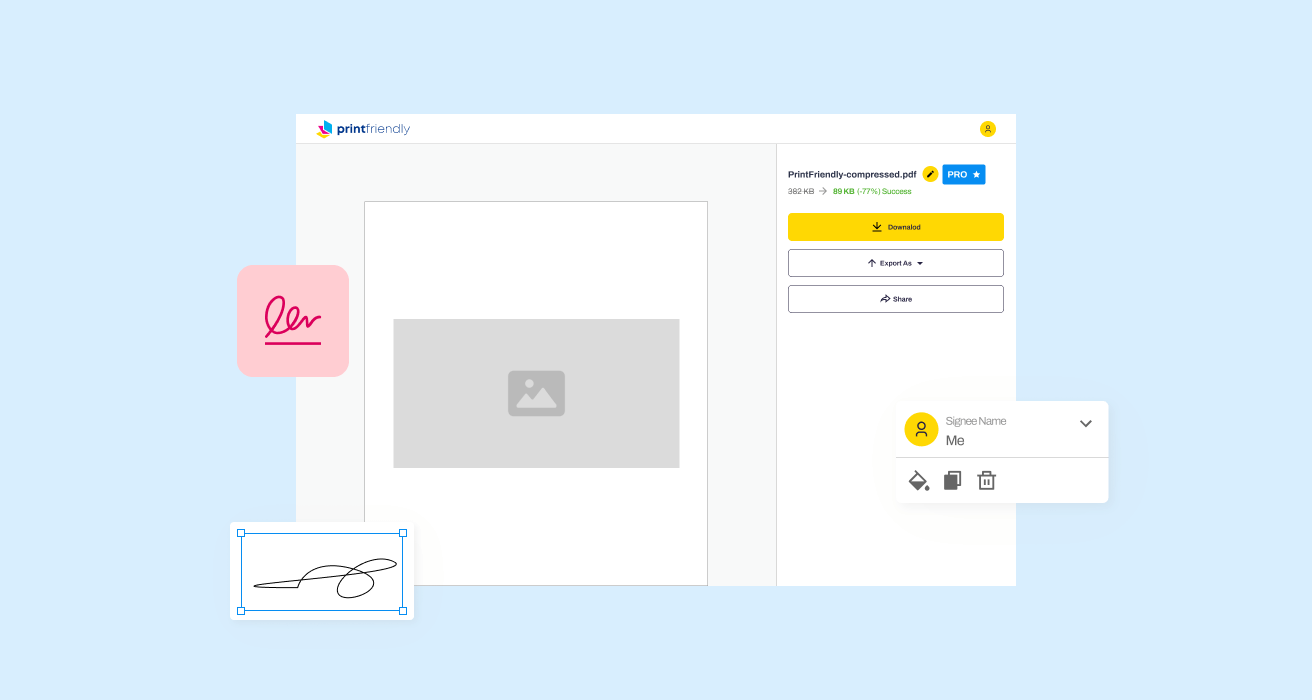
How to fill out the Understanding Do Not Resuscitate Orders and Forms?
1
Download the DNRO form from the official health department website.
2
Fill in the necessary details including patient information and medical representative, if applicable.
3
Have the form signed by a licensed physician to ensure it is valid.
4
Print the completed form on yellow paper as required.
5
Keep the form in an easily accessible location for emergency responders.
Who needs the Understanding Do Not Resuscitate Orders and Forms?
1
Individuals facing serious health conditions may need a DNRO to express their wishes for resuscitation treatments.
2
Aging adults wishing to communicate their end-of-life care preferences clearly.
3
Patients in hospice care who prefer not to undergo resuscitation efforts.
4
Families needing to ensure their loved one's last wishes are respected during medical emergencies.
5
Healthcare proxies who require a legally binding document to act on behalf of a patient regarding resuscitation wishes.
How PrintFriendly Works
At PrintFriendly.com, you can edit, sign, share, and download the Understanding Do Not Resuscitate Orders and Forms along with hundreds of thousands of other documents. Our platform helps you seamlessly edit PDFs and other documents online. You can edit our large library of pre-existing files and upload your own documents. Managing PDFs has never been easier.

Edit your Understanding Do Not Resuscitate Orders and Forms online.
With PrintFriendly, you can quickly edit this PDF to suit your needs. Make adjustments to the text, add notes, or remove unnecessary sections easily. The user-friendly interface allows for seamless edits before finalizing the document for printing.

Add your legally-binding signature.
Signing this PDF on PrintFriendly is straightforward with our new features. You can write your signature directly on the document or upload a scanned version. This ensures that your DNRO is compliant and ready for use.
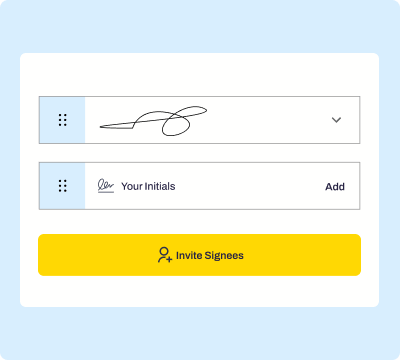
Share your form instantly.
PrintFriendly now allows you to easily share this PDF with others. You can send it via email or generate a download link for sharing. This feature makes it convenient to distribute important documents while retaining their formatting.
How do I edit the Understanding Do Not Resuscitate Orders and Forms online?
With PrintFriendly, you can quickly edit this PDF to suit your needs. Make adjustments to the text, add notes, or remove unnecessary sections easily. The user-friendly interface allows for seamless edits before finalizing the document for printing.
1
Open the DNRO file in PrintFriendly's PDF editor.
2
Make desired changes such as filling in patient information.
3
Add notes or annotations if required.
4
Review the changes for accuracy.
5
Save or download the modified form for print.

What are the instructions for submitting this form?
To submit the DNRO form, ensure it is printed on yellow paper and has the required signatures from both the patient and physician. Once completed, you can fax it to the Florida Department of Health at 850-558-9500 or mail it to 4052 Bald Cypress Way, Bin A-22, Tallahassee, FL 32399. Always keep copies for your records and share them with your healthcare proxies.
What are the important dates for this form in 2024 and 2025?
There are no specific expiration dates for the DNRO form; it remains valid indefinitely after completion. However, it's essential to ensure it's updated with any changes in circumstances or personal health status. Always consult with your physician regarding your current health before submitting the form.

What is the purpose of this form?
The purpose of the Do Not Resuscitate Order (DNRO) is to legally document a patient's wishes regarding resuscitation in emergency medical situations. It serves to ensure that healthcare providers respect the individual's choices about their end-of-life care, especially in cases of cardiac or respiratory arrest. Having a DNRO in place can relieve family members from making tough decisions during critical times.

Tell me about this form and its components and fields line-by-line.

- 1. Patient Information: Details regarding the patient's identity including name, date of birth, and signature.
- 2. Physician's Signature: A section for the physician to validate the DNRO with their professional signature.
- 3. Date of Issue: The date on which the DNRO is completed and signed.
- 4. Emergency Contact: Space to include emergency contacts for healthcare providers.
- 5. Health Care Surrogate Information: Details of the appointed health care surrogate, if applicable.
What happens if I fail to submit this form?
If you fail to submit the DNRO form, healthcare providers may not be aware of your wishes regarding resuscitation, which could result in receiving unwanted medical interventions during an emergency. It is crucial to communicate your end-of-life preferences clearly through the proper documentation.
- Lack of Clarity in Emergency Situations: Without the DNRO, medical personnel may default to resuscitation procedures.
- Family Confusion and Stress: Family members may struggle with decisions without formal documentation of your wishes.
- Potential Legal Issues: Healthcare providers may face dilemmas if they are unsure what actions to take, leading to possible legal complications.
How do I know when to use this form?

- 1. Serious Health Conditions: Patients with terminal illnesses should prepare a DNRO.
- 2. End-of-Life Planning: Individuals planning for end-of-life care should document their preferences.
- 3. Hospice Care Situations: Patients in hospice care can specify their level of medical intervention.
Frequently Asked Questions
What is a DNRO?
A Do Not Resuscitate Order (DNRO) is a legal document that specifies a person's wish not to receive resuscitation in the event of a respiratory or cardiac arrest.
How do I obtain a DNRO form?
You can download the DNRO form from the Florida Department of Health website or request one by mail.
Do I need a physician's signature?
Yes, a physician's signature is required to validate the DNRO.
Can I use this form outside of Florida?
No, the DNRO is only applicable within Florida.
Is the form to be notarized or witnessed?
No, it only requires the signatures of the patient and physician.
How should I store the DNRO?
Keep the DNRO in a visible and accessible location, readily available in case of emergencies.
Can I revoke my DNRO?
Yes, the DNRO can be revoked at any time by verbal or written notification.
Does the DNRO expire?
No, once completed and signed, the DNRO does not expire.
What if I make a mistake on the form?
You can edit the form on PrintFriendly before printing it.
Will 9-1-1 respond if I have a DNRO?
Yes, you can still call 9-1-1 for comfort care or if you wish to transport the patient to a hospital.
Related Documents - DNRO FAQs
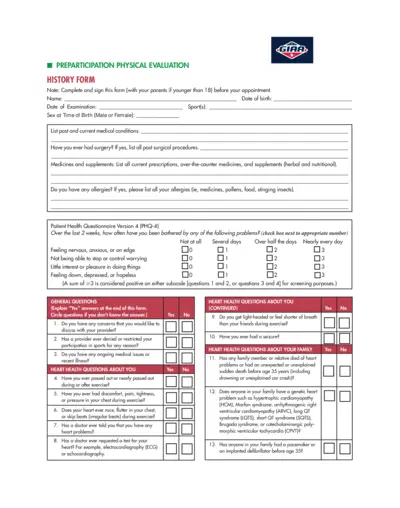
Preparticipation Physical Evaluation Form
The Preparticipation Physical Evaluation Form is used to assess the physical health and fitness of individuals before they participate in sports activities. It covers medical history, heart health, bone and joint health, and other relevant medical questions.
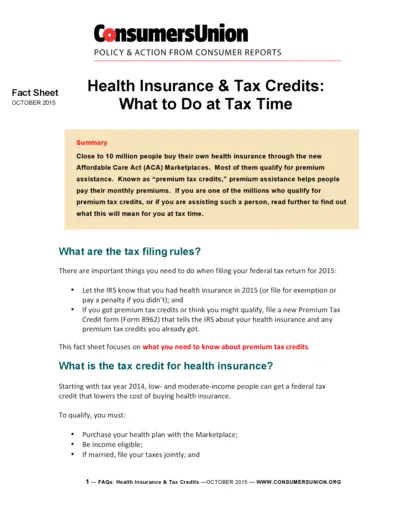
Health Insurance Tax Credits Guide 2015
This document provides a comprehensive guide on health insurance and premium tax credits for the 2015 tax year. It explains the tax filing rules, eligibility criteria, and detailed instructions for claiming and reporting premium tax credits. Essential for individuals who bought health insurance through the ACA Marketplaces.
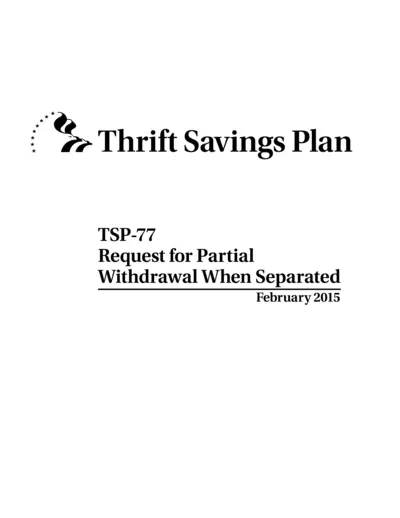
TSP-77 Partial Withdrawal Request for Separated Employees
The TSP-77 form is used by separated employees to request a partial withdrawal from their Thrift Savings Plan account. It includes instructions for completing the form, certification, and notarization requirements. The form must be filled out completely and submitted along with necessary supporting documents.
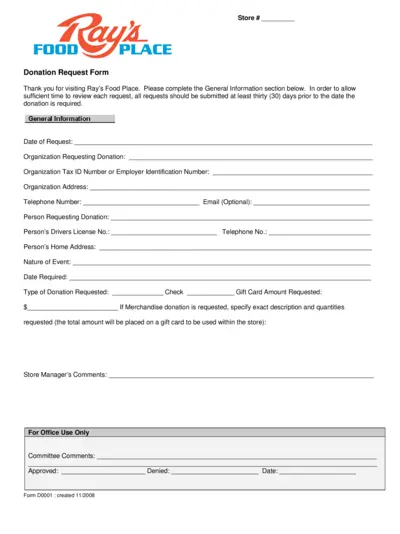
Ray's Food Place Donation Request Form Details
This file contains the donation request form for Ray's Food Place. Complete the general information section and follow the guidelines to submit your donation request at least 30 days in advance. The form includes fields for organization details and donation specifics.
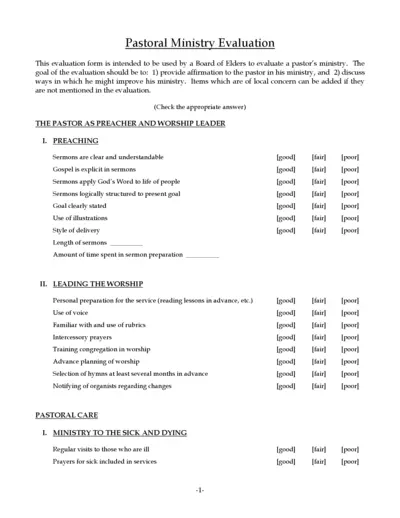
Pastoral Ministry Evaluation Form for Board of Elders
This evaluation form is designed for the Board of Elders to assess and provide feedback on a pastor's ministry. It aims to offer affirmation and identify areas for improvement. The form covers preaching, worship leading, pastoral care, administration, and more.
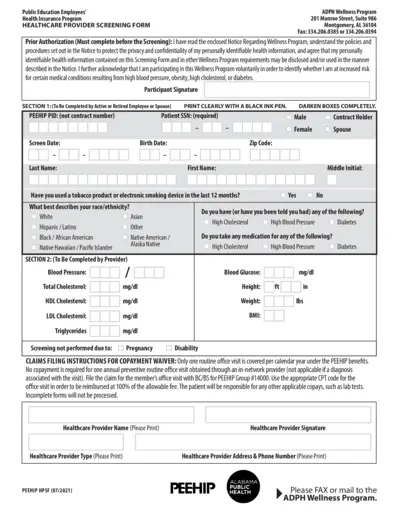
Health Provider Screening Form for PEEHIP Healthcare
This file contains the Health Provider Screening Form for PEEHIP public education employees and spouses. It includes instructions on how to fill out the form for wellness program participation. The form collects personal, medical, and screening details to assess wellness.
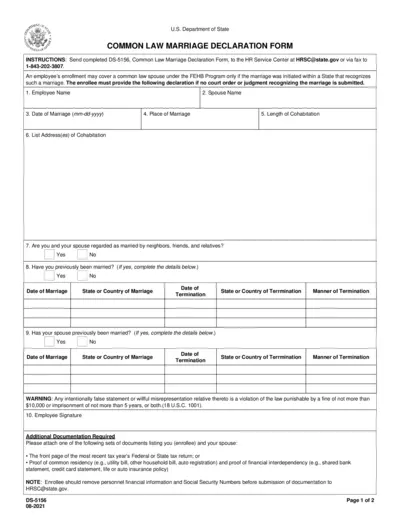
Common Law Marriage Declaration Form for FEHB Program
This form is used to declare a common law marriage for the purpose of enrolling a spouse under the Federal Employees Health Benefits (FEHB) Program. It requires personal details, marriage information, and additional documentation. Submission instructions and legal implications are included.
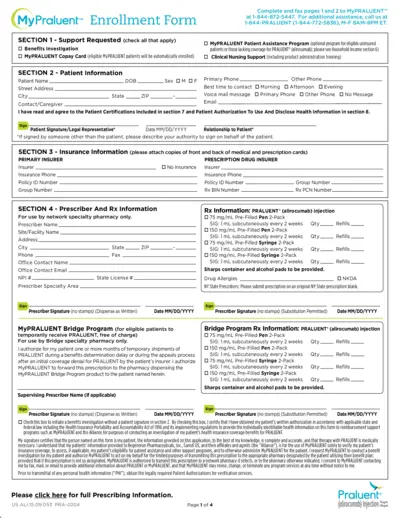
MyPRALUENT™ Enrollment Form Instructions and Details
This document provides comprehensive instructions and details for enrolling in the MyPRALUENT™ program, including benefits, patient assistance, and clinical support. It outlines the required patient, insurance, and prescriber information, as well as the steps for treatment verification and household income documentation.
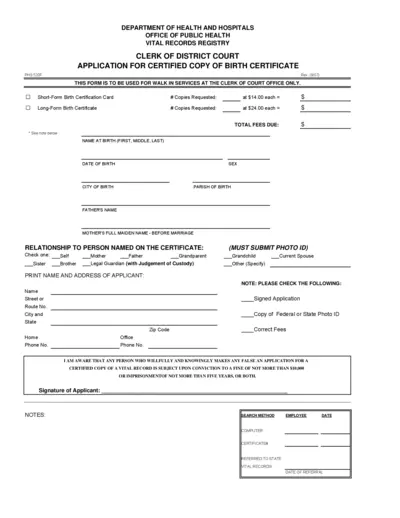
Application for Certified Copy of Birth Certificate
This form is used to request a certified copy of a birth certificate from the Clerk of Court Office. It includes details about the applicant, the person named on the certificate, and requires a photo ID and the correct fee. This form is only for walk-in services.
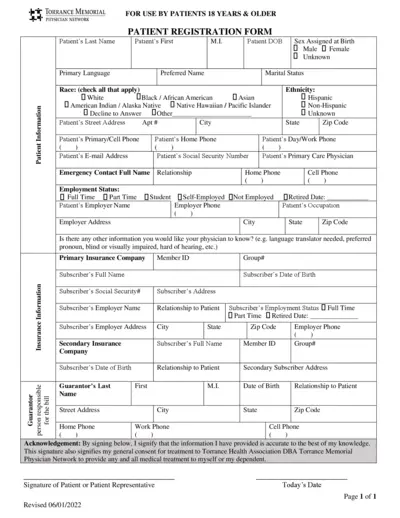
Torrance Memorial Physician Network Forms for Patients 18+
This file contains important forms for patients 18 years and older registered with Torrance Memorial Physician Network. It includes patient registration, acknowledgment of receipt of privacy practices, and financial & assignment of benefits policy forms. Complete these forms to ensure your medical records are up-to-date and to understand your financial responsibilities.
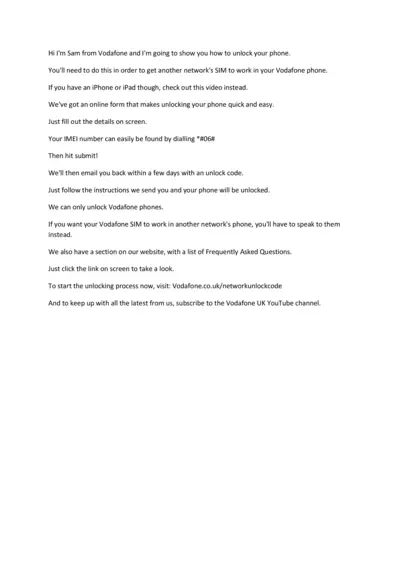
Vodafone Phone Unlocking Guide: Steps to Unlock Your Phone
This guide from Vodafone provides a step-by-step process to unlock your phone. Learn how to obtain your unlock code by filling out an online form. Follow the instructions to complete the unlocking process.
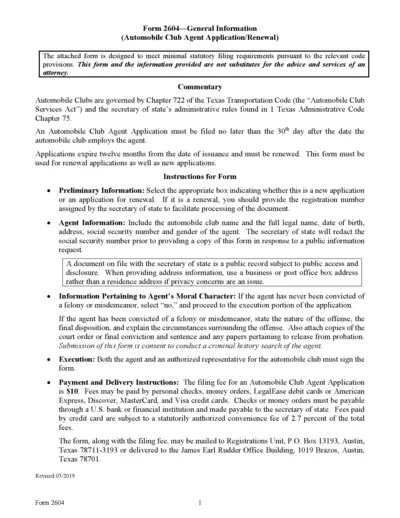
Texas Automobile Club Agent Application Form
This file is the Texas Automobile Club Agent Application or Renewal form, which must be submitted within 30 days after hiring an agent. The form includes fields for agent identification, moral character information, and requires signature from both the agent and an authorized representative of the automobile club. Filing fees and submission instructions are also provided.